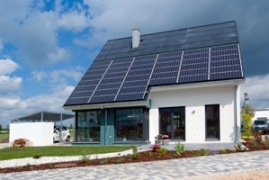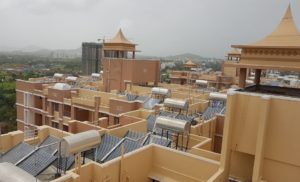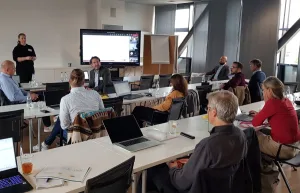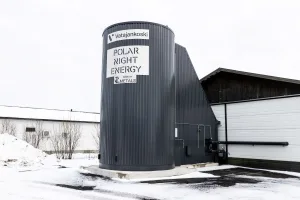

Germany: Independent of Energy Utilities
 Living without gas and electricity grid connection: On 5 May, German building promoter Helma Eigenheimbau AG inaugurated its first energy self-sufficient home located in the ‘show house park for sustainable construction’ at the company’s headquarters in Lehrte, Germany. The sun supplies the thermal energy required for hot water and space heating, as well as the electricity for the household and the electric car. As a result, the house is completely independent from any energy suppliers.
Living without gas and electricity grid connection: On 5 May, German building promoter Helma Eigenheimbau AG inaugurated its first energy self-sufficient home located in the ‘show house park for sustainable construction’ at the company’s headquarters in Lehrte, Germany. The sun supplies the thermal energy required for hot water and space heating, as well as the electricity for the household and the electric car. As a result, the house is completely independent from any energy suppliers.
Photo: Helma Eigenheimbau AG
A total of 46 m² of solar panels – integrated into the roof with a tilt of 45° and facing in the ideal southern direction – cover 65% of the home’s annual heating demand. In certain German regions, even a solar coverage up to 70% would be possible. With a 9.3 m³ long-term storage tank, solar heat can be stored for weeks – or even months – and stay available throughout every season for hot water preparation and heating of the 162 m² living space.
In less sunny times of the year, the storage tank additionally provides individually controlled room heating through wall or floor heating. A highly efficient oven meets the remaining heating needs of 1 to 2 solid cubic meter wood per annum. And, an incorporated water bag directs 90% of the biomass heating energy to the storage tank. The rest of the waste heat ensures comfortable temperatures in the living room.
In addition to the collectors, a 58 m² photovoltaic system has been integrated in the home’s roof. It covers the entire power consumption of the household, and supplies the electric car. An electric energy storage (battery) stores the energy for sunless days, and allows the electric car to be loaded even after sunset when coming home from work.
The price of the Helma house, which can be built in its current turnkey configuration throughout Germany, is EUR 363,000. The home-builder pays about a quarter of that sum – EUR 100,000 – for solar installations and storage technologies. “At this price, we offer the first affordable and market-ready energy self-efficient house in Europe,” the head of the project and an independent solar thermal planner, Timo Leukefeld from Freiberg, Germany, states. “In similar pilot projects of the Fraunhofer Institute or the German Federal Environment Ministry, the houses cost many times more.” And, the use of solar energy makes for great savings in energy costs, too: Leukefeld estimates a saving potential for electricity, heating and transport costs of EUR 4,000 to 4,500 during the first year, assuming a driving distance of 20,000 km.
A measurement and control system offers an intelligent and efficient use of the obtained energy. Sensors in each room can control lighting, shading and heating. During sunny days, the gained solar electricity is usefully distributed and consumed throughout the house. The control and regulation of this system is possible via internet.
The annual primary energy demand of the house amounts to 9 kWh/m². This is 88% below the threshold of the German energy saving regulations (ENEV), and about 70% less than what is required by the German passive house standard.
“The aim of our project has not only been to become independent of oil, gas or electricity supplies,” Karl-Heinz Maerzke, CEO of Helma Eigenheimbau AG, says. “We also looked for an integrated concept which could provide a sustainable, energy self-sufficient environment without any restrictions.” Leukefeld adds: “We want our customers to waste energy in an intelligent way. In contrast, the principle of the passive house bases on the fact that residents are limited in some respects.”
The sizes of the solar installations are especially designed to meet the heating and electricity demand during the less sunny winter months. In the summer, the PV system delivers additional solar power for the electric car. “Our concept doesn’t consider the generated power as investment property. Our aim is to consume the energy that is produced,” Leukefeld explains. “We want to reduce the consumption of conventional electricity instead of producing energy and feeding it into a grid.”
Currently, there are about 10,000 passive houses and 700 so-called solar houses in Germany. The latter are required to cover more than 50% of the annual heat demand for space heating and hot water by a solar thermal system. Energy-plus houses, which feed energy into a grid, have not yet been a very widespread phenomenon across the country.
More Information:
http://www.das-energieautarke-haus.de (German only)
http://www.sonnenhaus-institut.de (German only)
http://www.timo-leukefeld.de


